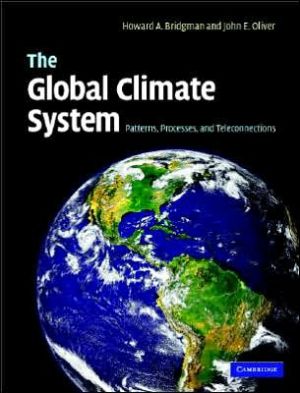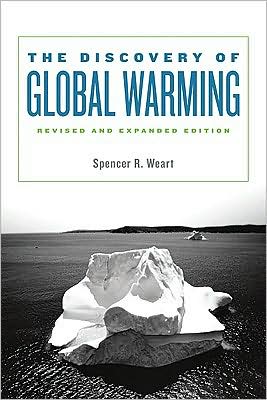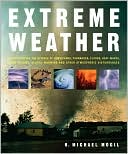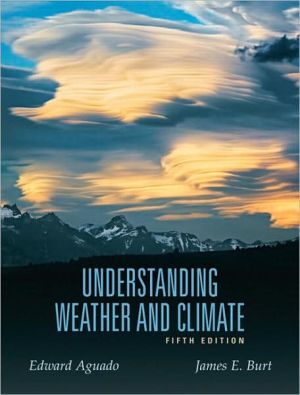The Global Climate System: Patterns, Processes, and Teleconnections
Over the last 20 years, developments in climatology have provided an amazing array of explanations for the pattern of world climates. This textbook examines the earth's climate systems in light of this incredible growth in data availability, data retrieval systems, and satellite and computer applications. It considers regional climate anomalies, developments in teleconnections, unusual sequences of recent climate change, and human impacts upon the climate system. The physical climate forms...
Search in google:
Advanced textbook that examines recent developments in regional climatology and global climates.
Cambridge University Press\ \ 052182642X - The Global Climate System - Patterns, Processes, and Teleconnections - by Howard A. Bridgman and John E. Oliver\ \ Excerpt\ \ \ \ \ \ \ Chapter 1\ Introduction\ 1.1 The climate system\ Climate is a function not only of the atmosphere but is rather the response to linkages and couplings between the atmosphere, the hydrosphere, the biosphere, and the geosphere. Each of these realms influences any prevailing climate and changes in any one can lead to changes in another. Figure 1.1 provides in schematic form the major couplings between the various components of the climate system. A climate-systems approach avoids the isolation of considering only individual climatic or atmospheric components. This approach recognizes the importance of forcing factors, which create changes on scales from long-term transitional to short-term sudden, and that the climate system is highly non-linear. According to Steffen (2001), a systems approach also recognizes the complex interaction between components, and links between the other great systems of the Earth, and the ways in which humans affect climate through the socioeconomic system. Ignoring such interactions may create inaccuracies and misinterpretations of climate system impacts at different spatial scales.\ In examining any component of the Earth’s atmosphere, its systems and its couplings, basic knowledge of the energy and mass budgets iscritical. Information concerning these is given in most introductory texts (Oliver and Hidore 2002; Barry and Chorley 1998) and they are not reiterated in detail here. Rather, the following provides a brief summary of major concepts.\ 1.1.1 Energy and mass exchanges\ Energy\ Every object above the temperature of absolute zero − 273 °C radiates energy to its environment. It radiates energy in the form of electromagnetic waves that travel at the speed of light. Energy transferred in the form of waves has characteristics that depend upon wavelength, amplitude, and frequency.\ The characteristics of the radiation emitted by an object vary as the fourth power of the absolute temperature (degrees Kelvin). The hotter an object, the greater the flow of energy from it. The Stefan–Boltzmann Law expresses this\ \ \ Image not available in HTML version\ \ \ Figure 1.1 A simplified and schematic representation of the Earth’s climate system.\ relationship by the equation F = σT4 where F is the flux of radiation emitted per square meter, σ is a constant (5.67 × 10− 8 W m− 2k− 4 in SI units), and T is an object’s surface temperature in degrees Kelvin.\ Applying this law, the average temperature at the surface of the Sun is 6000 K. The average temperature of Earth is 288 K. The temperature at the surface of the Sun is more than 20 times as high as that of Earth. Twenty raised to the fourth power is 160 000. Therefore, the Sun emits 160 000 times as much radiation per unit area as the Earth. The Sun emits radiation in a continuous range of electromagnetic waves ranging from long radio waves with wavelengths of 105 meters down to very short waves such as gamma rays, which are less than 10− 4 micrometers in length.\ Another law of radiant energy (Wien’s Law) states that the wavelength of maximum intensity of radiation is inversely proportional to the absolute temperature. Thus the higher the temperature, the shorter the wavelength at which maximum radiation intensity occurs. This is given by λmax = 2897/T where T = temperature in degrees Kelvin, and wavelength is in micrometers.\ For the Sun, λmax is 2897/6000 which equals 0.48 μm. For the Earth λmax is given by 2897/288, a wavelength of 10 μm. Thus the Sun radiates mostly in the visible portion of the electromagnetic spectrum and the Earth in the infrared (Figure 1.2). There is a thus a fundamental difference between solar and terrestrial radiation and the ways in which each interacts with the atmosphere and Earth’s surface.\ Utilization of these laws, and knowledge of Earth–Sun relations, enables the computation of the amount of energy arriving, the solar constant, and the nature of solar and terrestrial radiation. These are used to derive budgets of energy exchanges over the Earth’s surface. Box 1.1 provides basic information on this using the customary symbols.\ \ \ Image not available in HTML version\ \ \ Figure 1.2 Wavelength characteristics of solar and terrestrial radiation. Note the difference between extraterrestrial solar radiation and that incident at the Earth’s surface indicating atmospheric absorption of both short-wave ultraviolet and infrared radiant energy. Earth emits energy largely in the infrared portion of the spectrum. (After Sellers 1965)\ The climate at any location is ultimately related to net radiation (Q*) and is a function of a number of interacting variables. First, incoming solar radiation varies with latitude, being greatest at the equator and least at the poles. Hence, climate varies with latitude. Second, energy transformations at the surface are completely different over ice, water, and land, while also varying with topography, land use, and land cover. Climates will thus vary between such surfaces. The variation associated with such surfaces is seen in the heat budget equation.\ The heat budget explains the relative partitioning between sensible heat and latent heat transfers in a given environment. In a moist environment a large part of available energy is used for evaporation with less available for sensible heat.\ \ \ \ Background Box 1.1\ Energy flow representation\ The exchanges and flows associated with energy inputs into the Earth-atmosphere system is represented by a series of symbolic equations. Use of the equations permits easy calculation once values are input.\ Shortwave solar radiation (K↓) reaching the surface is made up of the vertical radiation (S) and diffuse radiation (D):\ \ \ Display matter not available in HTML version\ \ \ Some of the energy is reflected back to space (K↑) so that net shortwave radiation (K*) is the difference between the two:\ \ \ Display matter not available in HTML version\ \ \ Net longwave, terrestrial radiation (L*) comprises downward atmospheric radiation (L↓) less upward terrestrial radiation (L↑):\ \ \ Display matter not available in HTML version\ \ \ The amount of energy available at any surface is thus the sum of K* and L*. This is net all-wave radiation (Q*):\ \ \ Display matter not available in HTML version\ \ \ which may also be given as\ \ \ Display matter not available in HTML version\ \ \ Q* may be positive or negative.\ High positive values will occur during high sun periods when K↓ is at its maximum and atmospheric radiation, L↓, exceeds outgoing radiation, L↑.\ Negative values require outgoing values to be greater than incoming. This happens, for example, on clear nights when L↑ is larger than other values.\ On a long-term basis, Q* will vary with latitude and surface type.\ The heat budget\ Consider a column of the Earth’s surface extending down to where vertical heat exchange no longer occurs (Figure 1.3). The net rate (G) at which heat in this column changes depends upon the following:\ \ \ Net radiation (K ↑ − K ↓) + (L↑ − L ↓)\ \ \ Latent heat transfer (LE)\ \ \ Sensible heat transfer (H)\ \ \ Horizontal heat transfer (S)\ \ \ \ \ Image not available in HTML version\ \ \ Figure 1.3 Model of energy transfer in the atmospheric system.\ In symbolic form:\ \ \ Display matter not available in HTML version\ \ \ Since\ \ \ Display matter not available in HTML version\ \ \ then\ \ \ Display matter not available in HTML version\ \ \ in terms of Q*\ \ \ Display matter not available in HTML version\ \ \ The column will not experience a net change in temperature over an annual period; that is, it is neither gaining nor losing heat over that time, so G = 0 and can be dropped from the equation.\ \ \ Display matter not available in HTML version\ \ \ This equation will apply to a mobile column, such as the oceans. On land, where subsurface flow of heat is negligible, S will be unimportant. The land heat budget becomes\ \ \ Display matter not available in HTML version\ \ \ The ratio between LE and H is given as the Bowen Ratio.\ (After Oliver and Hidore 2002)\ \ \ \ The opposite is true in dry environments. The ratio of one to another is expressed by the Bowen Ratio; a high value would indicate that large amounts of energy are available for sensible heat, a low value indicates that much available energy is used for latent heat transfer. This partially explains why desert regions, which\ \ \ Image not available in HTML version\ \ \ Figure 1.4 Estimated amounts of water involved in the global hydrologic cycle.\ have high Bowen Ratios, can attain much higher temperatures than those in a maritime environment.\ Water and its changes of state\ The significance of water as an atmospheric variable is a result of its unique physical properties. Water is the only substance that exists as a gas, liquid, and solid at temperatures found at the Earth’s surface. This special property enables water to cycle over the Earth’s surface. Figure 1.4 illustrates the relative partitioning of water in the hydrologic cycle. As can be seen, a large proportion of the exchanges occur over the world oceans. While changing from one form to another, water in its various forms acts as an important vehicle for the transfer of energy in the atmosphere.\ The chemical symbol of water, H2O, is probably the best known of all chemical symbols. Water in all of its states has the same atomic content, the only difference is the arrangement of the molecules. At low temperatures the bonds binding the water molecules are firm and pack tightly in a fixed geometric pattern in the solid phase. As temperature increases, the available energy causes bonds to form, break, and form again. This permits flow to occur and represents the liquid phase of water. At higher temperatures and with more energy, the bonding between the water molecules breaks down and the molecules move in a disorganized manner. This is the gas phase. If the temperature decreases, the molecules will revert to a less energetic phase and reverse the processes. Gas will change to liquid and liquid to solid.\ The processes of melting, evaporation, and sublimation from solid to liquid to gas phase result in absorbed energy. This added energy causes the molecules to change their bonding pattern. The amount of energy incorporated is large for the changes to the water vapor stage, and much lower for the change from ice to water.\ The energy absorbed is latent energy and goes back to the environment when the phase changes reverse. When water vapor changes to liquid, it releases the\ \ \ Image not available in HTML version\ \ \ Figure 1.5 Idealized diagrams showing how interacting forces result in surface friction layer winds (left) and upper air, geostrophic winds (right). PGF, pressure gradient force; FR, friction; CE, coriolis effect.\ energy originally absorbed and retained as latent heat. The same is true when water freezes and water vapor sublimates to ice.\ The significance of the release of latent heat shows in many ways. For example, it plays a critical role in the redistribution of heat energy over the Earth’s surface. Because of the high evaporation in low latitudes, air transported to higher latitudes carries latent heat with it. The vapor in this air condenses and releases energy to warm the atmosphere in higher latitudes.\ Air in motion\ Newton’s first law of motion deals with inertia. It states that a body will change its velocity of motion only if acted upon by an unbalanced force. In effect, if something is in motion, it will keep going until a force modifies its motion. On Earth, a parcel of air seldom moves continuously and in a straight line. This is because, as Newton’s second law states, the acceleration of any body, in this case the parcel of air, is directly proportional to the magnitude of the net forces acting upon it and inversely proportional to its mass. Note that these laws concern acceleration, which is change of velocity with time.\ By identifying the forces that act upon a parcel of air, it becomes possible to understand more fully the processes that lead to the acceleration (or deceleration) of air. If we consider a unit parcel of air (m = 1), then Newton’s second law becomes\ \ \ Display matter not available in HTML version\ \ \ The ∑F is made up of the atmospheric forces so that:\ \ \ Display matter not available in HTML version\ \ \ The understanding and evaluation of each of these forces (or accelerations) provide the key to winds that blow, at both the surface and aloft, over the globe. This is schematically illustrated in Figure 1.5 where the interacting forces are shown to produce friction winds at lower levels of the atmosphere, and geostrophic winds aloft.\ 1.2 Patterns, processes, and teleconnections\ Since early times humans must have been aware of their climatic environment. Agriculturalists were faced with the impact of changing seasons, hunters followed migrating herds and fishermen experienced the vagaries of stormy seasons at sea. From such a beginning the study of climate, climatology, has evolved through numerous stages to the rigorous science that it now is. To assess aspects of the current understandings, it is useful to consider the global climate system in terms of its patterns, processes, and teleconnections.\ 1.2.1 Patterns\ In reviewing the history of climatology Oliver (1991) notes that the development of any discipline is closely associated with the logical organization, the classification, of the elements that are studied as part of that discipline. Such is very true of climatology, for the classification process dominated the discipline from the late nineteenth to the middle of the twentieth centuries. The effort and thought that went into studies have provided the modern climatologists with the basic ideas of the various patterns of climate that exist over the Earth’s surface. However, the zonal patterns that were originally postulated have been shown to be a major oversimplification, and have led to many misunderstandings about the nature of climates in various regions of the world. As an example, the climates that are grouped as the “tropical rainforest climate” are no longer perceived as monotonous, readily explained climates such as they were once described.\ It follows that one emphasis of this work, the patterns of climate over the Earth, need be examined in the light of new ideas and findings. To this end, the first chapters of this text use the long-recognized patterns – the tropics, mid-latitudes and polar realms – to identify climate types, but look at them in a way that brings together the dynamic understanding that has been the focus of recent research.\ But patterns are not just spatial; temporal patterns of climate must also be considered. Climate has varied in the past on many time scales. There have been long periods, more than 50 million years, of relatively undisturbed climates when conditions were warmer than the current climate (Ruddiman 2001). These time spans have been interrupted by shorter periods, a few million years or so, of quite variable climates. For about the past 2 million years climate has been in a disturbed period with ice ages alternating with milder interglacials. In this work, only a short temporal pattern is examined in detail. The last 1000 years or so is selected because of the impact of changing or variable climates upon people and their environments.\ 1.2.2 Process\ The second emphasis of this work concerns the processes that produce a climate. A dictionary definition of process states that it is a natural or involuntary course of action or a series of changes. In the milieu of climate, process may be regarded as a continuum of energy flow wherein available energy is utilized to maintain the climate system. The resulting global and local energy and mass budgets eventually provide the key to ongoing processes. Background Box 1.1 provides an example of the standard symbols used to depict energy flows in the environment and the relationship to the heat budget. Changes in energy flows then lead to changes in the nature of a climate and its resulting impact upon the human environment. Such is considered in a number of ways in this work. As already noted, the human response to changes over the last 1000 years is considered a temporal pattern. It also represents a change in the processes resulting in that climate. Another area where change is seen is in the urban environment. The buildings that comprise a town or city create conditions that result in a totally modified energy budget. The construction of an environment of cement and macadam results in changing moisture flows and patterns (Bonan 2002 and Chapter 7). Urban climatology has become a major area of specialization.\ One result of the intensive study of process is the development of the concept that any climate process that occurs at a given location does not vary or change independently of other, often far distant, processes. This has led to an area of research that deals collectively with teleconnections.\ 1.2.3 Teleconnections\ Teleconnection is a term used to describe the tendency for atmospheric circulation patterns to be related, either directly or indirectly, over large and spatially non-contiguous areas. The AMS Glossary of Weather and Climate (Geer 1996) defined it as a linkage between weather changes occurring in widely separated regions of the globe. Both definitions emphasize a relationship of distant processes. However, the word “teleconnection” was not used in a climate context until it appeared in the mid 1930s (Ångström 1935), and even until the 1980s was not a commonly used term in the climatic literature.\ As stressed throughout this book, teleconnections are often associated with atmospheric oscillations. Any phenomenon that tends to vary above or below a mean value in some sort of periodic way is properly designated as an oscillation. If the oscillation has a recognizable periodicity, then it may be called a cycle, but few atmospheric oscillations are considered true cycles. This is illustrated by the early problems in predicting the best-publicized oscillation, the Southern Oscillation and El Niño (Chapter 2). Were this totally predictable then many of its far-reaching impacts could be forecast.\ 1.2.4 People and climate\ The most important practical reason to understand the climate system is the link with people, their activities, and their decision making. The relationships between people and climate may be approached in many ways, often under the heading of Applied Climatology. Art, architecture, comfort, health, religion, and warfare are but a few of the topics considered (Oliver 1991). Of particular interest in this work is the role of people in what may be termed “problem climates”. The best known treatment of this topic is to be found in Trewartha’s book The Earth’s Problem Climates (1966). This work explored anomalies across the globe but, obviously, lacked explanations based upon the information that is available today. Nonetheless, the very title begs the question of what is a problem climate? This is thoughtfully considered in the following essay by Michael Glantz.\ Given the growth of world population and the immense impact upon the ecological systems of the Earth, the study of some problem climates faces a challenge. Is a recognized problem, such as a long-term drought, the result of natural climatic variation or is it the result of human activity.\ 1.3 ESSAY: Problem climates or problem societies?\ Michael Glantz, National Center for Atmospheric Research\ It cannot be denied that climate issues have made it to the top of the list of things to talk about. Those things to talk about include climate change to be sure, but also every week there is likely to be a weather or climate extreme occurring somewhere on the globe. At different times of the year we hear about adverse impacts of climate on agriculture, e.g. droughts in the out-of-phase growing seasons in the Northern and Southern Hemispheres.\ In addition to local, regional, and global concerns about specific climate and weather extremes in their own right, there is a deepening concern worldwide on the part of the public, political figures, and scientific researchers about the adverse effects of a variable and changing climate on human activities and the resources on which they depend: food production and security, water resources, energy production, public health and safety, early warning, economy and environment. Each of these concerns also raises serious ethical and equity concerns.\ The idea for this essay (and its title) is the result of three merging climate-related concerns: (1) an apparent overemphasis on blaming climate for many of society’s woes such as food and water shortages and surpluses, and public health and safety problems; (2) an apparent overemphasis on the speculation about global warming and its impacts on societies (usually adverse and way out into the future); and (3) an apparent underemphasis on society’s ability to influence the behavior of the atmosphere on all time and geographic scales. As a result of this underemphasis, societies are not forceful or determined enough to pursue changes in societal behavior in an attempt to minimize human influences on the atmosphere and therefore on local to global climate.\ \ \ © Cambridge University Press
1Introduction12Oscillations and teleconnections253Tropical climates594Middle-latitude climates965Climate of the polar realms1316Post-glacial climatic change and variability1717Urban impacts on climate2058Human response to climate change2449Essay : model interpretation of climate signals : an application to Asian monsoon climate28110Conclusions and the future of climate research309








